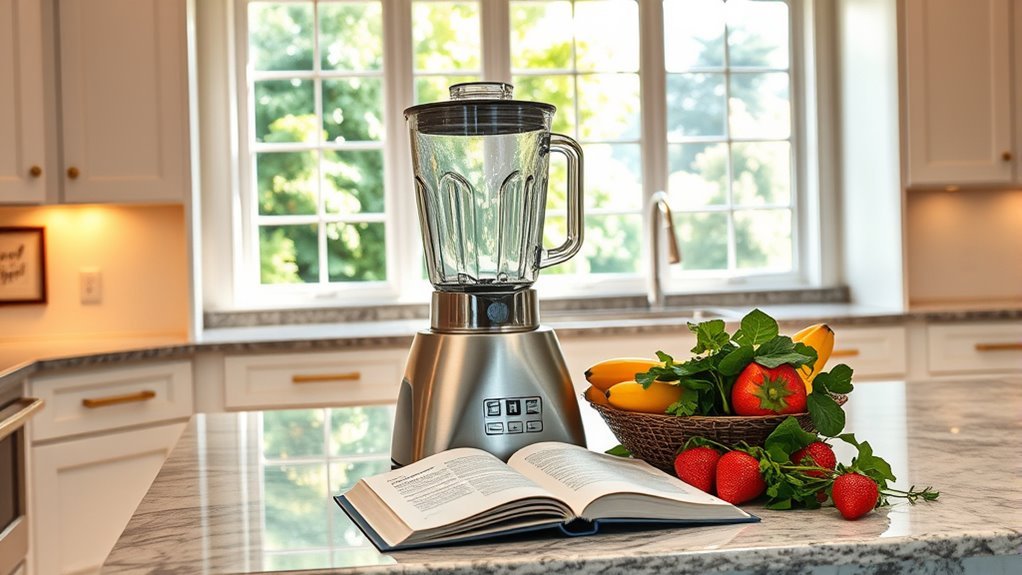Standard kitchen blenders blast out 80-90 decibels – that’s way above the safe 50-decibel threshold for sleeping infants. We’ve got to be smart about this: blend in a separate room, use sound barriers, and time your smoothie-making around baby’s schedule. Think of it like a lawn mower next to the crib – not ideal. Proper distance and sound management are critical, since continuous exposure above 70 decibels risks hearing damage. There’s more to protecting those tiny ears than you might think.
Understanding Decibel Levels in Common Kitchen Appliances

While kitchen appliances make our lives easier, they can produce noise levels that put our little ones at risk.
Let’s get specific: blender noise hits 80-90 decibels – that’s lawn mower territory. The American Academy of Pediatrics warns us to keep infants’ noise exposure under 50 decibels for safe sleep and hearing protection.
Here’s the reality check – your standard kitchen blender shatters that safety threshold. We’re talking potential hearing damage from continuous exposure above 70 decibels.
That’s why creating a protected sleep environment matters. Keep those noisy kitchen appliances at least 7 feet from where your baby sleeps. It’s not just about comfort – it’s about safeguarding your infant’s sensitive hearing during those vital early months.
Safe Sound Thresholds for Infant Sleep Environments
Because your infant’s developing ears are highly sensitive, maintaining proper sound levels in their sleep environment isn’t just a suggestion – it’s critical for their health.
The American Academy of Pediatrics sets safe sound thresholds at 50 decibels – think gentle rainfall, not thunderstorm. We’re monitoring noise levels to protect those tiny ears from hearing damage that continuous noise exposure above 70 decibels can cause.
- A white noise machine placed 7 feet from the crib creates the perfect buffer of soothing sounds
- Your normal conversation voice (50 dB) provides an ideal reference point for safe volume
- Common kitchen appliances like blenders (85+ dB) have no place near sleeping infants
Smart placement of white noise machines and strict decibel level monitoring aren’t optional – they’re your baby’s first line of defense against noise-induced hearing problems.
Measuring and Managing Blender Noise Around Babies

Blenders pose a serious noise hazard that we can’t ignore when it comes to infant sleep environments. The American Academy of Pediatrics warns us to keep noise below 50 decibels for infants, yet typical blenders blast at 85-95 decibels. Let’s manage this risk effectively.
| Action | Purpose | Impact |
|---|---|---|
| Use decibel meter app | Monitor noise | Prevent hearing damage |
| Separate room blending | Distance buffer | Reduce sound exposure |
| Time usage wisely | Avoid sleep periods | Maintain sleep quality |
| Check decibel ratings | Compare models | Choose quieter options |
| Regular maintenance | Reduce noise | Extend safe operation |
We’ve got to measure and manage blender noise systematically. Using a decibel meter app helps guarantee we’re maintaining safe levels. Remember: establishing a quiet sleep environment isn’t optional – it’s vital for infant hearing protection.
Sound-Proofing Strategies for Kitchen Noise Reduction
Since we’ve established the noise hazards in our kitchens, let’s tackle some hardcore soundproofing strategies that’ll transform your space into an infant-friendly zone.
Creating a quiet space for sleeping infants means attacking noise reduction from multiple angles. We’ll combine acoustic panels, heavy curtains, and strategic appliance placement to slash those decibels.
- Install acoustic foam panels on kitchen walls – they’ll trap sound waves like a sonic prison
- Add rubber mats under appliances and along walkways – think ninja-stealth for your footsteps
- Mount heavy curtains over windows and doorways – they’re like noise-canceling headphones for your kitchen
Long-Term Effects of Kitchen Noise Exposure on Infant Sleep

While we’d love to believe those brief kitchen noise bursts won’t hurt our little ones, the long-term impact tells a darker story. Prolonged exposure to kitchen noise above 70 decibels wreaks havoc on infant sleep quality and development. The American Academy of Pediatrics isn’t mincing words – keep those levels under 50 decibels, or risk serious auditory processing issues.
| Impact Type | Short-Term Effects | Long-Term Risks |
|---|---|---|
| Sleep | Disrupted cycles | Chronic patterns |
| Hearing | Temporary stress | Permanent damage |
| Development | Fussy behavior | Language delays |
Don’t fool yourself – those sudden noises from blenders aren’t just annoying; they’re potentially dangerous. Constant kitchen noise exposure masks critical speech sounds, derailing your infant’s auditory development. We’re talking about lasting consequences that extend far beyond a few disturbed naps.
Frequently Asked Questions
How Many Decibels Should an Infant Sleep?
We’ll want to keep our baby’s sleep environment at or below 50 decibels when using white noise or sound machines, maintaining soothing sounds that promote safe sleeping without risking hearing damage.
How Many Db Is Too Loud for an Infant?
We need to guarantee infant sleep remains under 50 decibels for safe environments, as anything above 70 decibels can harm our babies. Sound machines and white noise should maintain lower sound levels.
Is 55 Decibels Safe for a Baby?
We recommend keeping white noise and sound machines below 50 decibels for infant sleep safety. While 55 decibels isn’t immediately harmful, it’s above recommended levels for ideal sleep routines and calming environments.
What Is the Noise Level for Babies Sleep?
We should keep white noise levels in a baby’s sleep environment between 40-50 decibels, similar to gentle soothing sounds. Sound machines should be placed at least 7 feet away for ideal sleep safety.

